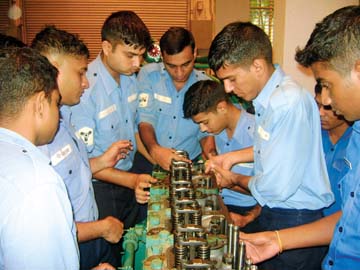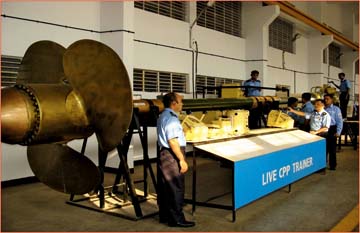|
The Indian Navy pioneers in keeping the man behind the
machine compatible with the state-of-the-art technology.
Peaceful, picturesque hills and environs of the Sahyadri
range in the Western Ghats, between Mumbai and Pune near
Lonavla is where the Indian Navy trains men to be friends
with their machines.
The Naval College of Engineering is actually part of the
Navy’s Engineering Training Establishment, designated INS
Shivaji, located there. An ISO 9001:2000 facility, it
imparts training to technical officers and engineering
sailors of the Indian Navy and Coast Guard and personnel
from foreign navies also, including Mauritius, Sri Lanka,
Seychelles, Maldives, Bangladesh, Tanzania, Kenya and some
others.
INS Shivaji conducts 81 courses with an annual throughput
of approximately 5,500 personnel. The role of the college
is to impart training in engineering and marine technology
to both officers and men whilst simultaneously ensuring a
balanced overall development of individual personality and
naval values. To this end, the establishment conducts ab-initio
and specialisation courses for officers and sailors.
The spectrum of officers’ training encompasses cadets training,
professional graduate level training at the Naval College of
Engineering and post graduate Marine Engineering Specialisation
Course (MESC) at the Centre of Marine Engineering Technology.
It also conducts the entry-level courses for sailors starting
with DEME courses of six months’ duration to three-year diploma
courses for Merged Artificer Apprentices.
In addition, specialisation and qualifying courses are conducted
for sailors in the mid-level for varying durations from six to
eleven weeks.

The Naval College of Engineering was commissioned by the late
Defence Minister VK Krishna Menon long back. The name of the
college has changed from Engineering and Electrical College to
the present one, the Naval Engineering College later.
INS Shivaji had its humble origin as replacement for the ‘Stokers’
Training School’ at HMIS Dalhousie, in Naval Dockyard, Bombay (now Mumbai).
Commissioned by the then Governor of Bombay, Sir John Colville, as HMIS
Shivaji on 15 February 1945, it became INS Shivaji on 26 January 1950.
Since then, the institution has dynamically evolved into a premier
technical training institution of the Navy keeping pace with the fast
changing technology in all facets of marine engineering.
To provide scope for further expansion and to isolate the trainee
sailors from the country’s politics, the Royal Indian Navy decided
to shift the training establishment from Bombay to a quieter place.
While the Britishers were on the lookout for a suitable location,
coincidentally an air accident took place in the Sahyadri Ranges.
Those who came to investigate the accident found more than what
they sought. Sandwiched between a sheer vertical rock face, covering
the entire height of the hill range (the Tiger’s Leap) on one side
and another imposing rock formation (the Duke’s Nose or Nagphani) on
the other, here was this flat piece of land.
No wonder this spot was immediately finalised for the establishment
by Commander Nott, Chief of Staff to the Flag Officer, Bombay.

Lt Cdr Joe Nuttal was given the responsibility of executing the move
under the guidance of Lt Cdr John Coverdale Smith, the officer-in-charge
of the Mechanical Training Establishment, who went on to become the first
Commanding Officer of HMIS Shivaji.
At Shivaji, the philosophies of ‘Practice Makes Perfect’ and ‘Work is
Worship’ have been amalgamated to form the ‘SKILL AT WORK’ motto.
The arm wielding the hammer, rising above the water, signifies the human
power and the dexterity of the man behind the machine, denoting a meaningful
liaison between subtle skill and gross power.
The 1000 plus strong Sagar Prahari Bal, the Navy’s security force formed
after the 26/11 terror attacks in Mumbai to protect country’s coastal areas,
also undergoes training at INS Shivaji. Operations and maintenance of equipment
in technical training courses is also imparted.
The campus has a Naval Engineering Museum that depicts evolution of marine
propulsion and Naval engineering systems and a Motivation Hall which provides
glimpses of the evolution of INS Shivaji. Other facilities include an Olympic-
size swimming-pool and a Watermanship Training Centre located at Shivasagar dam.
There is an outdoor classification range and an indoor firing range.

Spread over 876 acres, INS Shivaji has three institutions, the Naval College
of Engineering, Centre of Marine Engineering and Technology, and Nuclear,
Biological and Chemical Defence (NBCD) School. There is a Cadets Training
Department too.
The Naval College of Engineering undertakes B.Tech. courses at the entry-level
for technical officers’ entry into the Service. It is affiliated to JNU. The
faculty is a mix of (Defence Research and Development Organisation) DRDO scientists
and Naval officers.
The Centre of Marine Engineering Technology (CMET) is a vast facility equipped to
undertake ab initio, qualifying and marine specialisation courses for officers,
sailors and civilians. It also undertakes a specialised pre-commissioning training
of officers and sailors on actual equipment fitment onboard war vessels prior to
appointment.
The training wings also include the EPCT School. It has a Cadet’s Training
Department which is similar to an Officers’ Training Academy which undertakes
training of cadets in personality development, leadership qualities and waterman
ship, so as to groom them into effective leaders of men and efficient managers of
technology.
The NBCD School imparts training in nuclear, biological and chemical aspects,
damage control and fire-fighting. It has a world class damage control simulator
namely Akshat. It is an excellent facility for practical training in simulated
damage control procedures onboard ship.
Notably, all combat assets of the Indian Navy, including warships, have NBC
safefuards.
Needless to say, INS Shivaji plays a key role in marrying minds and technologies.
|